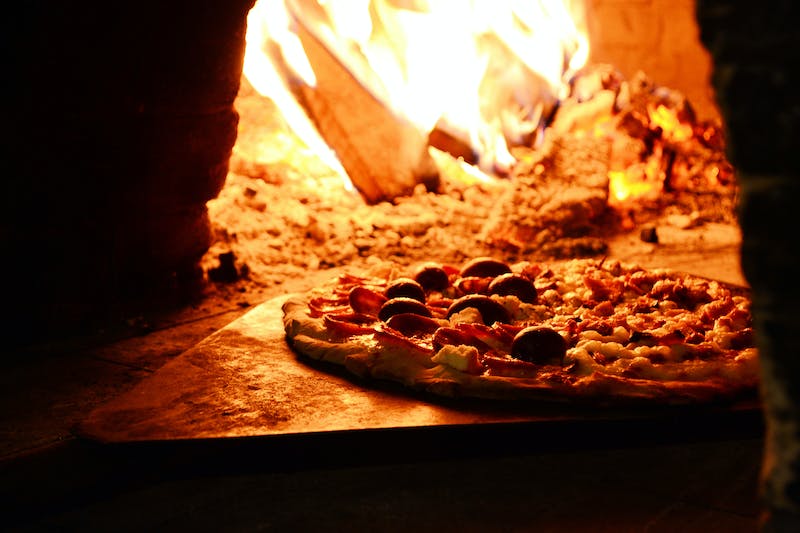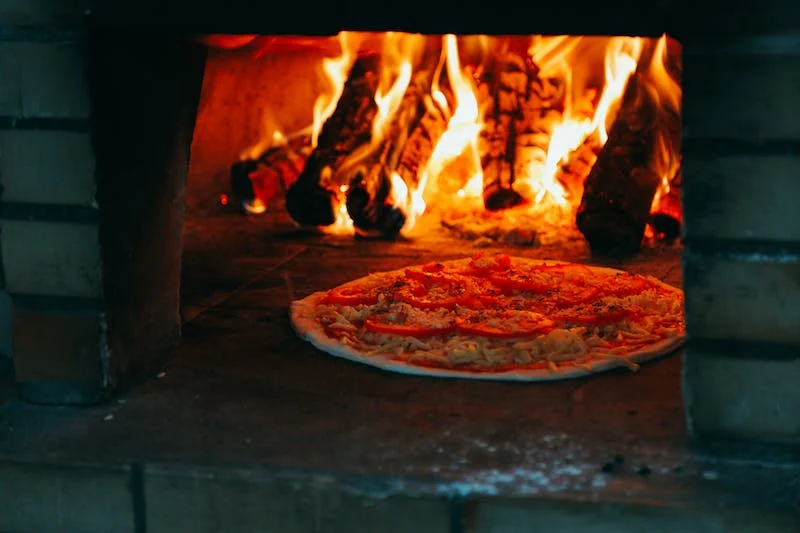Embarking on the culinary adventure of pizza-making, one quickly discovers that the heart of this art lies not just in the quality of the ingredients or the skill of the pizzaiolo, but crucially, in the fiery belly of the pizza oven itself. The temperature at which a pizza cooks is pivotal, transforming humble dough and toppings into a sublime, crispy, and perfectly melted masterpiece. In our in-depth exploration titled “How Hot is a Pizza Oven,” we delve into the scorching world of pizza ovens, uncovering the secrets that lie within these vaults of intense heat.
Our aim is to arm both the aspiring home chef and the seasoned professional with knowledge and insights that deepen their understanding and appreciation of the pizza-making process. By establishing expertise on the topic, demonstrating the value of understanding your oven’s temperature, and igniting curiosity about the nuances of pizza cooking, “How Hot is a Pizza Oven” promises to be an enlightening read.
The Science of Heat in Pizza Cooking

Temperature matters because of heat transfer – how heat moves from one object to another. Pizza ovens transfer heat in three key ways:
- Conduction – direct contact of the hot oven floor cooks the dough
- Convection – hot air circulates and browns the crust
- Radiation – infrared heat from oven walls melts and bubbles the cheese
This rapid, multi-directional heat transfer results in:
- A crisp, charred crust
- Blistered, browned cheese
- Caramelized, sweetened toppings
- A tender, chewy interior crumb
Low, steady heat dries out pizza. High heat brings out its best properties.
Why High Temperatures are Key to Perfect Pizza
Home ovens max out around 500°F. How does doubling that heat help?
- Fast cooking – Neapolitan pizza bakes in 60-90 seconds at 800°F. Leisurely cooking dries it out.
- Gas expansion – Heat makes gasses in the dough expand for a light, airy crust.
- Browning – Temperatures above 300°F initiate the Maillard reaction for flavorful browning.
- Killing yeast – High heat stops yeast growth that would continue to expand and ruin the crust.
- Melting cheese – Low heat makes cheese greasy. High heat allows it to melt and brown.
- Killing microbes – The high temperatures sanitize the oven’s cooking surface.
In short, high heat rapidly transforms simple dough and toppings into perfect pizza with an unbeatable crust.
Types of Pizza Ovens and Their Temperatures
Now that we appreciate the need for heat, let’s examine different ovens.
Traditional Wood-Fired Ovens
The gold standard. Wood ovens burn wood or wood pellets to reaches 700 – 1000°F.
The brick or stone retains heat for consistent baking. The live fire adds smoky undertones.
True Neapolitan pizza requires a wood oven certified by the VPN (Verace Pizza Napoletana).
Commercial Pizza Ovens
Gas-fired conveyor ovens move pizzas through them on a belt. The enclosed heating elements above, below and around the pizza allow temperatures up to 800°F.
Deck ovens place the pizza directly on a stone or metal surface heated to 600 – 650°F.
Both offer high output for restaurants.
Home Ovens and Pizza Stones
Read on to learn more : How To Cook Pizza In Microwave? Easy Microwave Pizza
Standard electric or gas ovens only go to 500°F at most. A pizza stone helps absorb and radiate more heat for better browning.
Some home oven tips:
- Place stone on the lowest rack
- Preheat for 30-60 minutes
- Rotate the pizza midway
You’ll get decent results, but can’t match a true pizza oven.
Fuel Types and Their Impact on Temperature
The fuel source significantly influences an oven’s capabilities.
Wood ovens can use various hardwoods like oak, maple, or fruit woods. Different types add subtle flavor nuances. But moisture content and size uniformity must be monitored to control heat.
Gas ovens connect to natural gas lines or propane tanks. Turning a valve controls the flame, making it easy to achieve and adjust high heat.
Electric ovens use heating coils. As long as the unit can support high wattages, temperatures are consistent. But heat-up time may increase.
Each fuel has pros and cons. Wood ovens require the most effort but impart the most flavor. Home cooks may prefer gas or electric for ease of use.
How Hot Is A Pizza Oven?
Now we can appreciate how hot is a pizza oven.
| Pizza Style | Temperature |
|---|---|
| Neapolitan | 800 – 900°F |
| New York | 550 – 650°F |
| Chicago Deep Dish | 425 – 500°F |
| Sicilian | 475 – 525°F |
New York’s longer bake time requires moderated heat. Deep dish needs a gentler oven to cook the thick crust through without burning.
You can make great pizza in any oven. But respecting the ideal temperature for each style results in authentic, optimal pies.
Advanced Temperature Control Techniques
In professional kitchens, what tools finely tune oven temperature?
- Thermocouples mounted inside the oven provide accurate real-time readings through digital controllers.
- Adjustable gas valves or forced air controls allow chefs to alter the heat source intensity.
- Wood or coal amounts in a fire-based oven control its output.
Digital displays provide precision. But old fashioned visuals work too – checking the oven floor color or fire intensity.
Read on to learn more : Pizza Party? Find Out How Many Slices In a 10 Inch Pizza
Temperature variances still occur in small batches. Allow +/- 25°F flexibility for best results.
The Role of Oven Materials
An oven’s construction influences how it handles heat. Common materials include:
- Brick – Traditional material that absorbs and retains heat well. Withstands high temperatures.
- Stainless Steel – Heats and cools quickly. Easy to clean and maintain. Provides conductive surface.
- Stone – Soapstone, clay, and tile bake evenly. Natural material unaffected by high heat.
- Ceramic – Affordable option for home ovens. Provides good insulation.
The right materials distribute heat in ways that complement the oven design and fuel source. This optimizes performance and longevity despite extreme temperatures.
Environmental and External Factors Affecting Oven Performance
While chefs control oven settings, outside conditions also play a role:
- Ambient temperature – If it’s hot outdoors, ovens heat faster and retain higher temperatures. In winter, you may need to increase the thermostat.
- Humidity – Wet weather makes ovens work harder. Adjust your dough hydration to account for humidity.
- Wind – Open ovens are impacted by drafts. Use wind barriers as needed.
- Altitude – Higher elevations reduce air pressure. Adjust cooking times longer.
Practical Tips for Perfect Pizza Every Time
We’ve covered the science. Now let’s apply it for pizza perfection.
Preheating and Cooking Times
- Allow 1-2 hours for full preheating, depending on oven size.
- Cook times range from 1-5 minutes for thin crust and up to 45 minutes for thick crust or deep dish.
- For home ovens, use the broiler setting at full blast just for the last 1-2 minutes to add char.
Dough Hydration and Gluten Development
- High protein flour and proper kneading allows the gluten network to form.
- 55-70% hydration adds moisture for an open crumb and chewy bite.
- The short, high heat cooking sets the structure before gluten over-develops.
Safety and Maintenance
- Oven mitts, long tongs, and Makor hats protect from burns.
- Keep ovens clean by brushing out debris with a wire brush between uses.
- Replace worn gaskets to prevent heat loss.
- Install fire extinguishers and follow safe refueling practices.
The Environmental Considerations of Pizza Cooking
How can high heat pizza ovens operate sustainably? Ways include:
- Burning sustainable sourced wood pellets or using renewable natural gas
- Insulating oven walls to retain heat and reduce fuel usage
- Using electric ovens powered by solar panels or wind energy
- Ordering ingredients from local vendors to reduce transport pollution
- Composting any leftover dough and food waste
Well-designed ovens benefit from efficiency. We can counter their energy intensity through smart operation and fuel choices.
Beyond Traditional Ovens: Alternative Cooking Methods

While specialized ovens excel for pizza, home cooks can improvise with:
- Grills – Use a pizza stone and achieve 700°F+ direct heat
- Cast iron skillets – Preheat upside-down on the grill
- Kamado smokers – Ceramic egg grills isolate heat up to 800°F
The direct contact and air flow mimic brick and deck ovens. Don’t be limited by your equipment.
Pairing Toppings with Oven Temperatures
Match the oven heat level to the delicacy of the toppings:
- Low temp for delicate ingredients like prosciutto, anchovies, or leafy greens – 500°F
- Medium for meats and veggies – 600-700°F
- High heat for minimal toppings like cheese, oil, herbs – 800°F+
Adjust cooking times too. Par-bake meatballs, onions or peppers beforehand if needed.
Troubleshooting Common Pizza Cooking Challenges
| Issue | Solution |
|---|---|
| Burnt crust, undercooked center | Lower temp 25°, use pizza stone, rotate regularly |
| Undercooked crust | Raise temp 25°, cook 2-3 min. longer |
| Soggy crust | Reduce sauce, add toppings sparingly |
| Pale, blonde crust | Preheat thoroughly, use broiler 1-2 min. at end |
| Stuck dough | Dust peel, don’t overload, jiggle pizza when placing |
| Uneven cooking | Rotate pizza, rearrange oven racks |
Don’t stress mistakes. Analyze results and tweak next time. You’ll be an oven expert in no time.
Conclusion: How Hot Is A Pizza Oven
We demystified the science behind harnessing high heat for pizza perfection. Whether you use a specialized oven or home techniques, remember:
- Match the temperature to the pizza style
- Preheat thoroughly and use cooking timers
- Adjust for external factors like weather
- Experiment with multiple cooking methods
- Implement sustainable practices
The joy of pizza lies in the journey. Appreciate your unique oven’s capabilities. With passion and the right temperature, you’ll achieve pizza nirvana in your own kitchen.

Chef John Sebastian has been cooking up a storm at his simple place for years. Offering a variety of international foods, Chef John Sebastian has something for everyone- and he makes it all look easy!
He’s been featured in various food magazines and cooking shows, and his restaurant has become a local favorite in the community. When he’s not in the kitchen, Chef John Sebastian enjoys spending time with his family.









